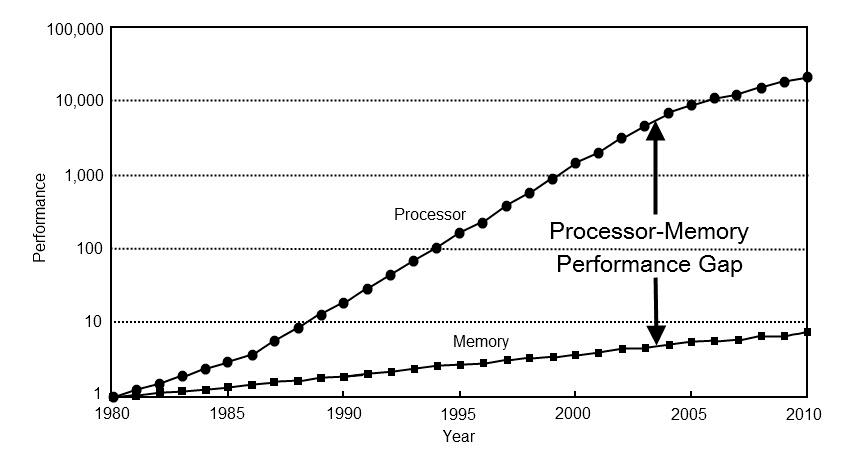工程师需要知道的latency 数字
看到一篇博客,叙述了当前内存对于数据的处理速度对于开发的影响,推而广之,找到了一些我们在做系统设计的时候需要熟知的一些数据。
首先处理器的处理速度和内存的处理速度是差距很大的,处理器的处理速度的增长速度要比内存的快很多。

我们需要探究的是CPU从内存中随机提取数据以及获取连续数据的速度,这是很粗略的估计,只是希望能够有一个数量级上的感知。
Latency Comparison Numbers (~2012)
----------------------------------
L1 cache reference 0.5 ns
Branch mispredict 5 ns
L2 cache reference 7 ns 14x L1 cache
Mutex lock/unlock 25 ns
Main memory reference 100 ns 20x L2 cache, 200x L1 cache
Compress 1K bytes with Zippy 3,000 ns 3 us
Send 1K bytes over 1 Gbps network 10,000 ns 10 us
Read 4K randomly from SSD* 150,000 ns 150 us ~1GB/sec SSD
Read 1 MB sequentially from memory 250,000 ns 250 us
Round trip within same datacenter 500,000 ns 500 us
Read 1 MB sequentially from SSD* 1,000,000 ns 1,000 us 1 ms ~1GB/sec SSD, 4X memory
Disk seek 10,000,000 ns 10,000 us 10 ms 20x datacenter roundtrip
Read 1 MB sequentially from disk 20,000,000 ns 20,000 us 20 ms 80x memory, 20X SSD
Send packet CA->Netherlands->CA 150,000,000 ns 150,000 us 150 ms根据2020年StackOverflow上的回答,我们可以看到Core i7 Xeon 5500 的benchmark数据如下
Core i7 Xeon 5500 Series Data Source Latency (approximate) [Pg. 22]
local L1 CACHE hit, ~4 cycles ( 2.1 - 1.2 ns )
local L2 CACHE hit, ~10 cycles ( 5.3 - 3.0 ns )
local L3 CACHE hit, line unshared ~40 cycles ( 21.4 - 12.0 ns )
local L3 CACHE hit, shared line in another core ~65 cycles ( 34.8 - 19.5 ns )
local L3 CACHE hit, modified in another core ~75 cycles ( 40.2 - 22.5 ns )
remote L3 CACHE (Ref: Fig.1 [Pg. 5]) ~100-300 cycles ( 160.7 - 30.0 ns )
local DRAM ~60 ns
remote DRAM ~100 ns而现在的cache的大小,根据wikiChip上的数据,对于Core i7-8700K
Memory Bandwidth: 39.74 gigabytes per second
L1 cache: 192 kilobytes (32 KB per core)
L2 cache: 1.5 megabytes (256 KB per core)
L3 cache: 12 megabytes (shared; 2 MB per core)Reference
- https://www.forrestthewoods.com/blog/memory-bandwidth-napkin-math/?
- https://stackoverflow.com/questions/4087280/approximate-cost-to-access-various-caches-and-main-memory
- https://en.wikichip.org/wiki/intel/core_i7/i7-8700k
- https://gist.github.com/jboner/2841832
转载请注明来源,欢迎对文章中的引用来源进行考证,欢迎指出任何有错误或不够清晰的表达。可以在下面评论区评论,也可以邮件至 stone2paul@gmail.com
文章标题:工程师需要知道的latency 数字
文章字数:535
本文作者:Leilei Chen
发布时间:2020-02-21, 13:08:38
最后更新:2020-02-21, 13:10:12
原始链接:https://www.llchen60.com/%E5%B7%A5%E7%A8%8B%E5%B8%88%E9%9C%80%E8%A6%81%E7%9F%A5%E9%81%93%E7%9A%84latency-%E6%95%B0%E5%AD%97/版权声明: "署名-非商用-相同方式共享 4.0" 转载请保留原文链接及作者。

